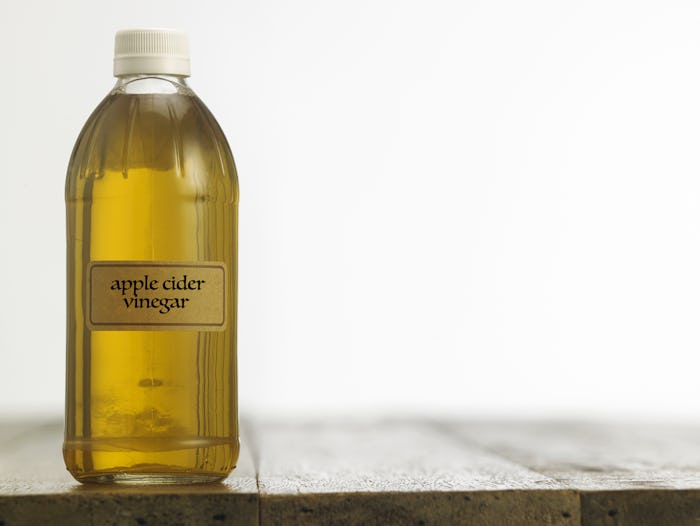Life

Here's The Truth Behind Using Apple Cider Vinegar To Get Rid Of Stretch Marks
Yes, the women who boldly and confidently embrace the signs of birth that their bodies bear are incredibly inspiring. Whether you're seeing them at the beach with their families or in a selfie on Instagram, women who roar are making us all a little more comfortable in our post-baby bodies. But different women have different levels of comfortability with (literal) birth marks, and it's OK to remedy them if you personally want to. There are a plethora of home remedies being touted these days, but one new one caught my eye. Can apple cider vinegar get rid of stretch marks? I turned to some experts to find out, and there seems to be a discrepancy of professional opinion.
New York City-based plastic surgeon Dr. Ryan Neinstein says there is reason to believe it's worth a try. According to Neinstein, the benefits of this particular vinegar go back thousands of years, as it is recorded that Hippocrates prescribed a mixture of honey and apple cider vinegar for treatment of various diseases in the year 400 B.C.
Neinstein explains to Romper in an exclusive interview, "Apple cider vinegar's antioxidant properties are believed to help prevent stretch marks that inflammatory conditions like pregnancy can create. A common at-home strategy is to fill a spray bottle with a cup of apple cider vinegar and spray it on the stretch mark areas at night, allowing it to dry and take effect. Anecdotally it seems to be helping."
But other professionals disagree. Seattle dermatologist Dr. Heather Rogers tells Romper that from her perspective, "Vinegar does not help". Rogers explains that there is data to suggest that stretch marks may be prevented by daily moisturizer, but no definitive ingredients have emerged as bringing special benefit. "I recommend to my patients to moisturize your tummy, breasts, and thighs every night, particularly during the third trimester with a hydrating product they like to use," she directs, "Preferably without common allergens such as fragrance or lanolin."
Both Neinstein and Rogers encourage women to focus on prevention rather than treatment, but acknowledge that sometimes the presence (or lack thereof) of stretch marks is really out of their hands. Rogers identifies the risk factors for stretch marks during pregnancy as being under 30 years old, having a mother who had stretch marks during pregnancy, gaining more than 35 pounds, and a Body Mass Index (BMI) over 27. Neinstein estimates that 50 to 90 percent of women experience stretch marks during pregnancy.
Yippee.
For the record, the medical terminology for stretch marks is Striae Distensae, according to Neinstein. While the plastic surgeon emphasizes that they are common nuisances, he also acknowledges that they can come with significant physical and psychological impact, as many women know all too well. Striae Distensae, Neinstein says, "Tend to affect the abdomen, buttocks, thighs, breasts, back, armpit, and groin. Stretch marks begin as 'reddish slightly depressed streaks which lighten in color over time, fading to leave pale wrinkled lines on the skin by about six months after giving birth."
Both Neinstein and Rogers confirm that the only definitive treatment plans involve laser therapy or surgery, and are not safe for pregnant or breastfeeding women. Rogers adds that a prescription-strength vitamin A cream can help build collagen back up in the skin, but again must be applied only after the woman is finished breastfeeding.
But if you want to go the natural route, there's no reason not to give the old apple cider vinegar remedy a try; even if it doesn't work, you'll only be out a couple of bucks. And who knows, maybe Hippocrates was on to something. There's only one way to find out.
Check out Romper's new video series, Romper's Doula Diaries:
Watch full episodes of Romper's Doula Diaries on Facebook Watch.
This article was originally published on